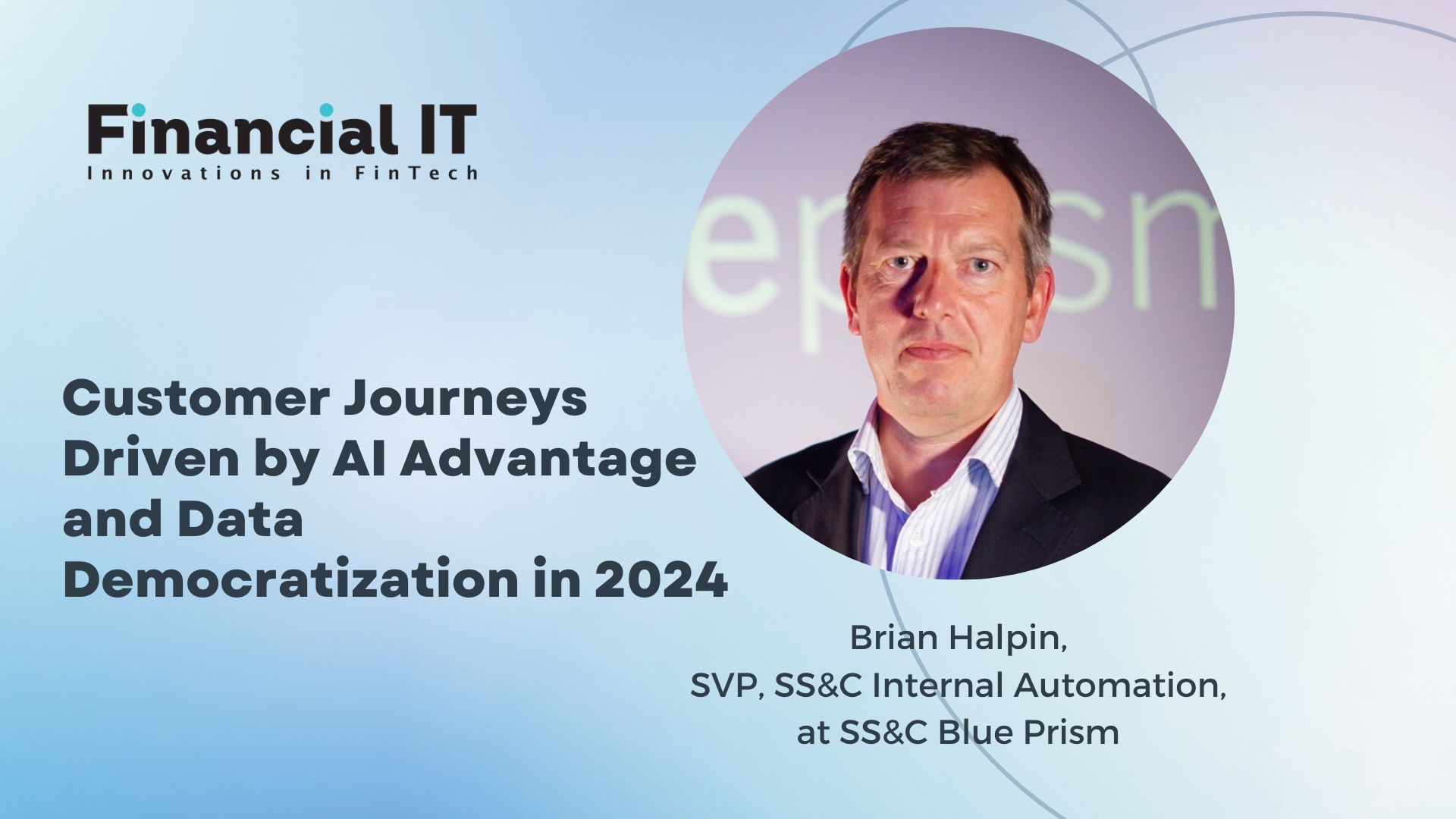Customer Journeys Driven by AI Advantage and Data Democratization in 2024

- Brian Halpin, SVP, SS&C Internal Automation at SS&C Blue Prism
- 15.02.2024 10:15 am #AI #Banking #data #genZ
With lending restrictions tightening and interest remaining relatively high, 2024 looks set to be the year of the customer as competition for eligible clients will intensify, whether you are in retail or investment banking.
In this rapidly evolving landscape, banks are fervently exploring avenues to harness the transformative power of generative artificial intelligence (Gen AI). Faced with the dual imperatives of speed and security, financial institutions are on the lookout for innovative strategies that promise not only efficiency but also a competitive edge.
Simultaneously, the year 2024 is poised to witness monumental progress in the realm of data democratization. This pivotal shift underscores a commitment to making data more accessible, fostering a culture of inclusivity in decision-making processes across industries.
Moreover, as we navigate the technological terrain, 2024 emerges as the breakthrough year for customer journeys. Organizations are gearing up to revolutionize the way they engage with their clientele, recognizing the imperative to create seamless, personalized, and memorable experiences that transcend traditional boundaries.
In tandem, another critical focus area for enterprises in 2024 is realizing the value of employee talent potential. Acknowledging the pivotal role human capital plays in organizational success, businesses are proactively seeking strategies to unlock and maximize the potential of their workforce, thereby driving innovation and sustained growth.
SS&C Blue Prism’s Brian Halpin has gathered insights from hundreds of banking and finance technology evangelists and business operations to delve into the key transformative industry trends and insights. As a leader in intelligent banking automation, his strategic recommendations will help you empower your organization and navigate the dynamic landscape of 2024 and beyond.
Banks will look for fast but safe ways to gain competitive advantage through Gen AI
Automation and AI are well-established within the banking sector with SS&C deploying machine learning and natural language (NLP) for many years across its fund administration services in areas such as reconciliations and settlement.
Within consumer banking, there are still, however, many repetitive tasks that are undertaken across the customer lifecycle using up the valuable time of employees without good reason. There remains enormous scope to improve the customer experience through technology as banks continue their path to digital transformation.
The big wins for retail banking in 2024 will be around how Gen AI can be used to drive these inefficiencies out of their business and improve by using customer experience automation. By applying Gen AI to simple tasks – such as instantly alerting new loan applicants to missing, inconsistent, or incomplete data in their application forms – customer dropout rates are reduced, and turnaround times are improved.
Similarly, we will see chatbots become more sophisticated in the coming year, as banks look for new cost-effective ways of helping customers to find the information they need. By resolving client issues quickly and efficiently and deepening the level of personalization, product offerings, and campaigns will have more customer appeal.
With lending restrictions also tightening and high global interest rates, the competition for eligible customers will intensify and any investments that banks can make to get a competitive edge are likely to be money well spent. Moreover, with questions around ethics and security still hot topics for debate within Gen AI, consumer banks will focus on enhancing existing technology rather than newer areas such as Gen AI-powered advisory.
However, the cost of running Gen AI infrastructure and hiring the required talent can be substantial and we believe banks will cherry-pick low-risk programs to quickly improve the customer experience and drive growth, allowing employees to carry out higher-value work and providing support to help them make more informed decisions.
AI regulation will be the watchword for 2024 as regulatory task forces begin to get to grips with AI consumer protection laws. The leading banks will need to keep a close eye on how Gen AI is deployed at both an individual and departmental level and be confident that software providers who are racing to embed GenAI in technology are conducting due diligence. By combining strong governance and oversight, automation itself will play a key role in monitoring how Gen AI tools are accessed – everything from tracking individual logins and monitoring usage to reporting and archiving data outputs.
The year for opening banking and data democratization
For the new emerging technologies to bring real business value, banks need the right data in place and be able to access data sources that traditionally sit in different formats across departments and non-interoperable systems. Only then will they be able to build new partnerships, and create new value with personalized insights and personalized products.
Not for the first time, legacy systems and organizational siloes are hampering the progress banks are making on their digital transformation journeys.
On the flip side, customers are also making greater – and more advantageous – use of democratized data. Open banking is also set to finally become mainstream in 2024, especially with regulatory hurdles due to be cleared in the U.S., and with embedded finance growing at pace, retail customers need a clear line of sight into their ever-more complex financial arrangements. By providing customers with a single view of all the financial institutions they choose to entrust their money with or borrow from, they can make faster or more strategic decisions.
We are also now seeing an escalation in the use of intelligent automation as one of the tools to solve data silo problems caused by legacy systems and inconsistent data types.
As banks become more mature and confident in their deployment of automation software, we believe open banking will drive greater digitized and structured customer data that is more accessible, organized, and analyzed to serve both institutions and customers alike.
Making data democratization a reality will also offer customers – across different segments –to benefit from receiving highly personalized or bespoke offers allowing them to make better financial decisions around their investments and loans using their real-time data. With appropriate governance and guardrails in place, banks can use this data to make better decisions and gain a deeper understanding of customers and how to serve them.
Will 2024 be the breakthrough year for customer journeys?
Building better customer journeys has been a retail banking priority for some time, with onboarding being the dominant automation use case. We believe 2024 will be the breakthrough year retail banks finally crack the nut of offering great experiences within the customer journey.
From established processes such as mortgage applications, through niche services such as closing accounts, to micro journeys such as ID verification or credit card replacement, these infrequent or once-in-a-lifetime customer journeys help define the loyalty and recommendation of customers for many years.
We think 2024 will be a pivotal year for customer journeys for three reasons. Firstly, the last two years have seen a flurry of fintech firms focusing on niche customer segments and their associated journeys. With investment funding drying up, we see much of this knowledge and skill coming into traditional retail banking through acquisition or talent hiring.
Secondly, the era of flatlining interest rates is over for now and churn will increase. We believe this impetus for customers to switch providers is finally taking hold. Consumers – even unhappy ones – are notoriously reluctant switchers, but if you can offer a fabulous switch account journey that puts the customer at ease, you will win market share and retain new customers.
Thirdly, the new generation of intelligent automation (IA) tools enables banks to build these new customer journeys – with faster ‘know your customer’ checking, digital onboarding, and designing seamless processes – meaning customers can get what they want quickly, and without pain. For younger customers, this will always mean digital banking.
Realizing the value of employee talent potential
The global talent gap is possibly the biggest invisible battle being fought by every institution across the finance industry, as in a tightening labor market, the fight for talent to deliver new transformation programs will continue unabated.
Banks have the choice to either pay for the best and brightest or develop their education programs that build careers. From new starters to seasoned employees, recruitment is often slow, and with high churn rates is a big turn-off for prospects, so onboarding processes are a big deal and set the stage for careers in banking.
Gen Zs born around the millennium, have specific goals and values driven by the need that take their domain expertise and translate it into bringing technological advantage to their line of business.
Again, banks need to decide when to use automation and AI to make their roles more fulfilling, or as a way of replacing the most soul-destroying processes with technology altogether. Get it right and you’ve not only got employees for life, but also as advocates and customers.
Bank on automation delivering more satisfying results in 2024
By designing great customer journeys, making data accessible across the organization, and taking away the menial and laborious tasks in banking operations, and focusing people on higher-value work, employees can look forward to 2024 and beyond with better career options, satisfied customers, and more interesting work.





















